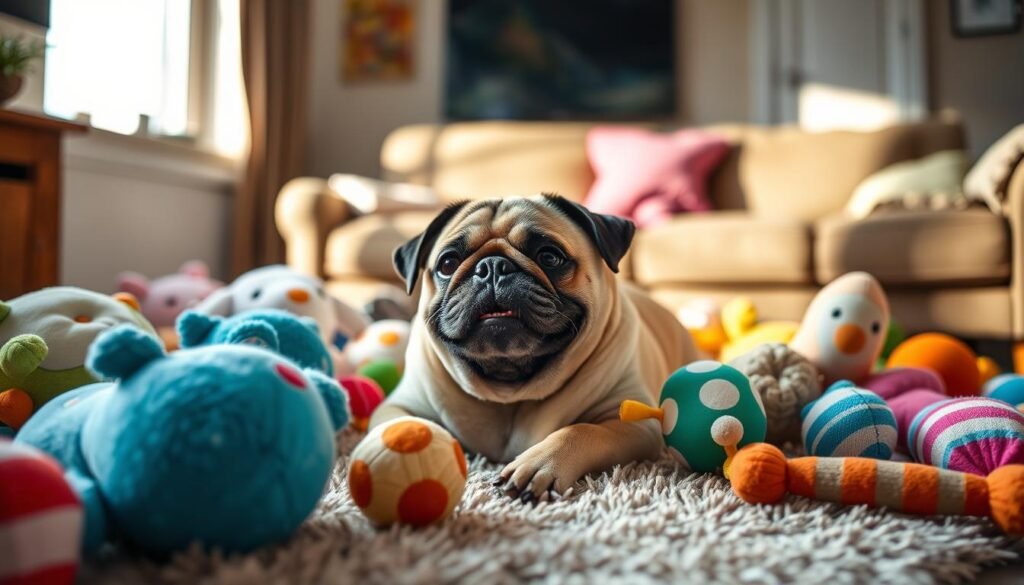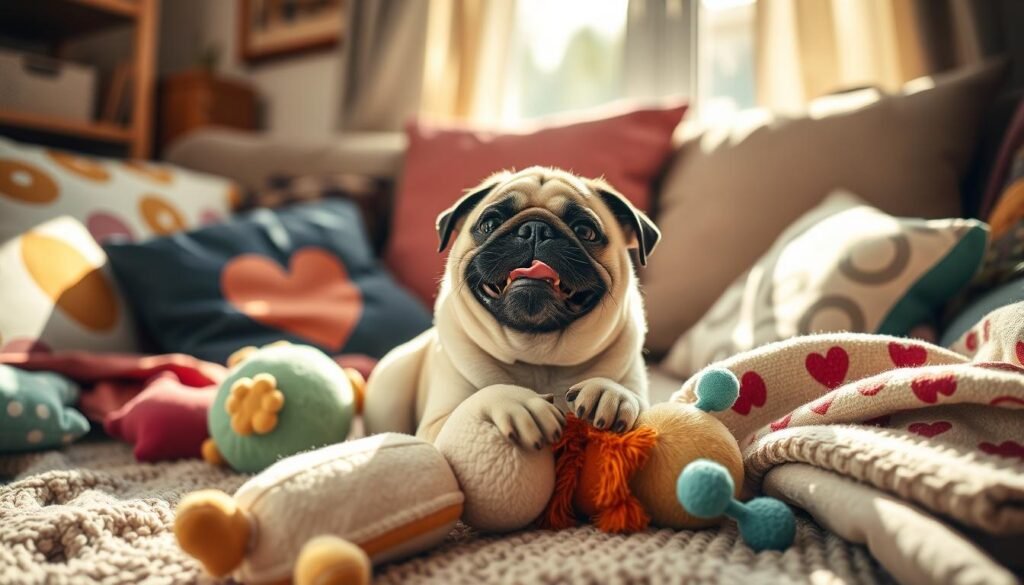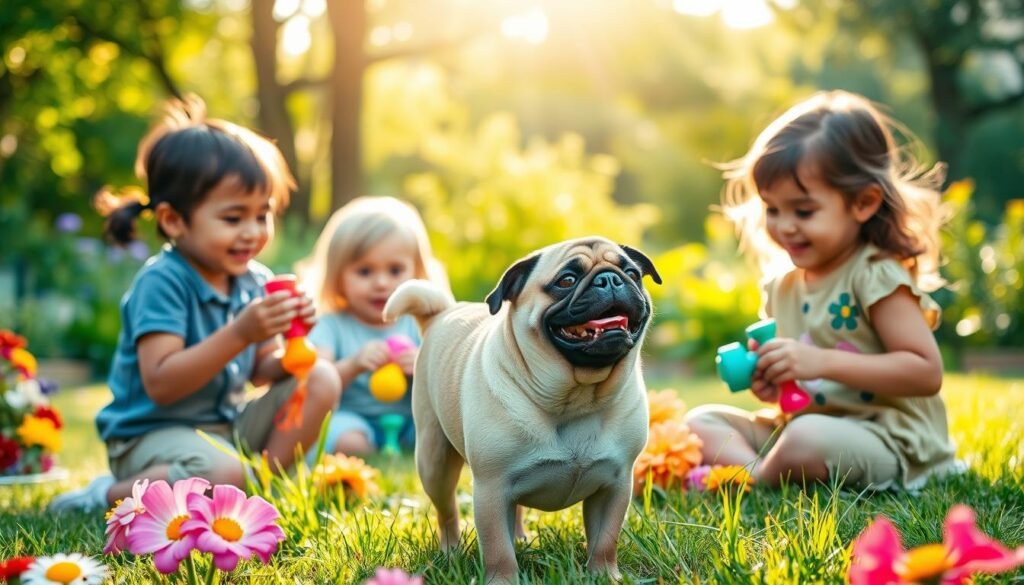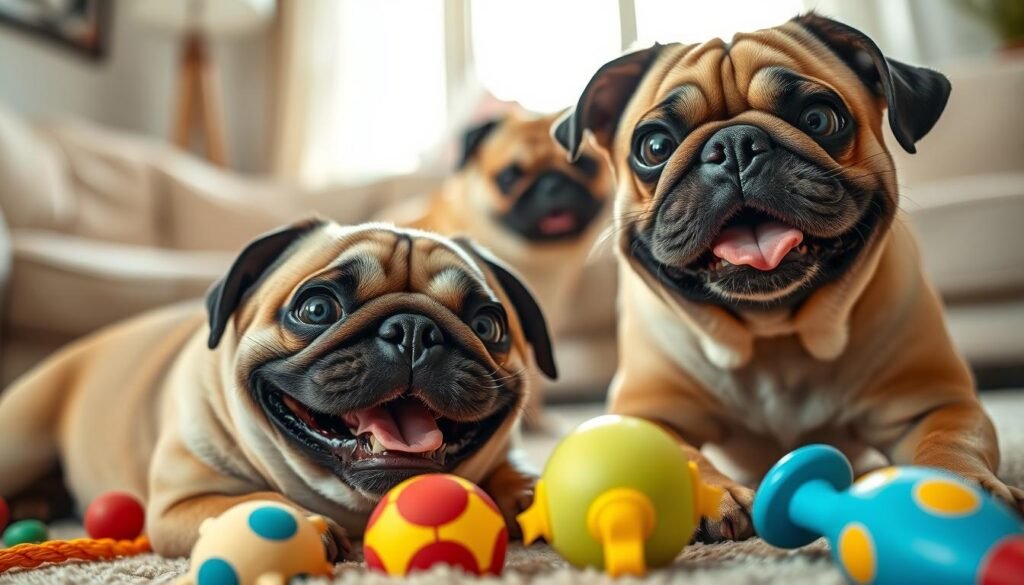How to avoid rough play that can injure your Pug
Did you know that 7 out of 10 Pug owners have seen their pets get hurt from rough play? This shows how crucial it is to know the dangers of rough play and teach your Pug gentle play habits. By focusing on your Pug’s safety, you can make sure they stay happy, healthy, and playful for years to come.
Pugs are full of energy and love to play, but their small size and fragile bones make them prone to injuries. As their owner, it’s up to you to make sure they play safely. Create a safe space for your Pug to enjoy playtime without worrying about getting hurt.
Understanding the Risks of Rough Play with Pugs
Pugs are lovable companions, but they can easily get hurt during rough play. As a pug owner, it’s important to know the risks. You should also take steps to keep your furry friend safe.
Why Pugs are Susceptible to Injuries
Pugs have a special body type that makes them more likely to get hurt. Their short, stocky build and big eyes can lead to problems like back injuries, eye trauma, and breathing issues. These issues are important to think about when playing with your pug.
Common Injuries Resulting from Rough Play
Common injuries from rough play with Pugs include back injuries, eye trauma, and breathing problems. Their face and eyes are easily hurt by sudden movements or accidents. Their breathing can also get strained, causing breathing issues.
It’s important to be careful about these health concerns when playing with your pug. By understanding the risks and taking safety steps, you can help your pug have a happy and safe life.

“Responsible pet ownership can reduce the risk of injuries during rough play between dogs, with statistics showing that attentive supervision can prevent accidents.”
Remember, your pug’s well-being is the most important thing. By knowing their special needs and taking steps to protect them, you can make playtime safe and fun for your furry friend.
Establishing Gentle Playtime Habits
Creating a gentle playtime routine is key to avoiding injuries in your pug. Through consistent training and reinforcement, you can teach your pug to play gently. This avoids the risks of rough play.
Begin by teaching your pug cues for gentle play, like “gentle” or “easy.” Reward them with treats and praise for calm, gentle play. This shows them that gentle play is the norm.
Give your pug fun ways to release energy, like playing fetch or tug-of-war with safe toys. These activities let them play hard while staying safe. Always watch them closely and step in if play gets too rough.
Teach children and guests how to play with your pug right. Show them to approach calmly, avoid chasing or grabbing, and let your pug start contact. This keeps your pug safe and happy during play.
By always encouraging gentle pug play techniques and giving them fun ways to play, you create gentle pug playtime habits. This keeps your furry friend safe and happy.

“Positive pug behavior modification and pug exercise needs are key to ensuring your pug’s safety and well-being during playtime.”
How to avoid rough play that can injure your Pug
As a Pug owner, keeping your pet safe during play is key. Rough play might seem fun, but it can hurt your Pug. It’s important to set clear rules for playtime to keep them safe.
Start by teaching your Pug to stop rough play with a command like “settle.” Always watch when your Pug plays with others, especially kids or guests. This helps avoid accidents.
- Put any rough play behaviors on a cue, such as “playfight” or “wrestle.”
- Teach your Pug the “settle” command to help them calm down after playtime.
- Closely monitor interactions, particularly with children or guests, to intervene before play becomes too intense.
Watch for signs that your Pug is too excited or upset. If they seem stressed, it’s time to stop play and give them a calm space.
“Certain owners allow rough play with their Pugs but remain cautious about teaching proper behavior regarding bite inhibition and interactions with others.”
Being proactive and consistent helps make playtime safe and fun for your Pug. Always put your pup’s safety first.
Teaching gentle play habits and watching play closely can prevent injuries. It also strengthens your bond with your Pug.
Supervising Playtime with Children and Guests
When your Pug plays with children or guests, watching closely is key for safety. Pugs are friendly but small and sometimes energetic. This can lead to risks during play. By watching closely, you can avoid accidents and injuries.
Educating Children on Safe Pug Interactions
Before kids play with your Pug, teach them how to do it right. Show them to approach calmly, not pull fur or tail, and touch gently. Tell them to respect the Pug’s space and boundaries. This helps kids play safely and builds a good bond.
Also, let kids help with Pug activities like training or grooming. This helps them understand and appreciate Pugs more. It leads to gentler and more considerate play.

“The relationship between a child and their dog can bring joy and wonder, creating memorable and positive experiences for both parties.”
Even the best Pug might not know when play is too rough. As the owner, you must step in to stop any dangerous play. This keeps your Pug and everyone else safe.
Recognizing Signs of Overstimulation or Distress
Playtime with your Pug should be fun for both of you. It’s key to watch for signs of pug stress. Knowing your Pug’s pug body language and pug emotional cues helps keep playtime positive.
Lip licking is a sign of stress in Pugs. If your Pug is licking their lips a lot, they might be feeling overwhelmed. If they start turning away or trying to get away, it’s a sign they need a break. Changes in breathing or vocalizations, like panting or whining, also show they’ve reached their pug play limits.
If you see these signs, it’s time to give your Pug a break. Respecting their boundaries and letting them calm down during play is crucial. It prevents injuries and keeps playtime enjoyable for everyone.

Every Pug is different, so get to know your Pug’s unique play style. By recognizing signs of pug stress and acting on them, you ensure your Pug’s playtime is safe and fun.
Positive Reinforcement for Calm and Gentle Behavior
It’s important to encourage calm and gentle behavior in your Pug to avoid injuries. Use positive reinforcement to shape their habits and ensure safer play. Give treats, praise, and play with toys when they act calmly and gently. This teaches them the value of these behaviors and encourages them to play nicely.
Positive reinforcement is a great way to train your Pug. It rewards good behavior instead of punishing bad ones. This method strengthens your bond and encourages the behaviors you want. By consistently rewarding calm play, you can change your Pug’s behavior and keep everyone safe.
Every Pug is different, so tailor your training to fit your dog’s personality and history. With patience and consistency, you can help your Pug enjoy safe and fun playtime. This benefits both of you.

